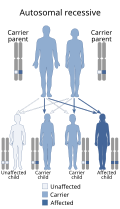Junior blood group system
| ABCG2 (Junior blood group antigen) | |||||||
|---|---|---|---|---|---|---|---|
| Identifiers | |||||||
| Symbol | ABCG2 | ||||||
Chr. 4 q22.1 | |||||||
| |||||||
The Junior blood group system (or JR) is a human
Genetics

The gene
Epidemiology
The highest rates of the Jr(a) negative blood type have been reported in Japan,
Clinical significance
Anti-Jr(a) antibodies are generally composed of Immunoglobulin G and develop when individuals are exposed to Jr(a) positive blood through pregnancy or blood transfusion. Some cases of anti-Jr(a) have been reported in patients who have not been previously transfused or pregnant.[2][5]
Jr(a) is more strongly expressed on
ABCG2 is a uric acid transporter, and the Jr(a) negative phenotype is associated with gout in Japanese populations.[8]
Laboratory testing
An individual's Junior blood type can be determined by
Anti-Jr(a) antibodies are most easily detected by the
History
The Junior blood group system was discovered in 1970 by researchers Stroup and MacIllroy, who reported on five patients whose blood was incompatible with all samples tested except each other's. They named the causative antigen "JR" after Rose Jacobs, one of the five patients — the common name "Junior" is in fact a misnomer.[2]
In 2012, two research groups[6][10] independently identified ABCG2 as the basis of the Junior blood group system. The Junior system was officially designated a blood group by the International Society of Blood Transfusion that year.[11]
References
- ^ a b c Kniffin CL (2013). "OMIM entry # 614490 – Blood Group, Junior System, Jr". Online Mendelian Inheritance in Man. Retrieved 1 September 2019.
- ^ S2CID 24659443.
- S2CID 2562261.
- ^ S2CID 52933848. Archived from the original(PDF) on 2021-07-13. Retrieved 2019-09-17.
- ^ ISBN 978-1-118-49354-0.
- ^ PMID 22246505.
- PMID 31324575.
- ISBN 978-0-323-50971-8.
- S2CID 3229027.
- S2CID 20854378.
- S2CID 84328440.
